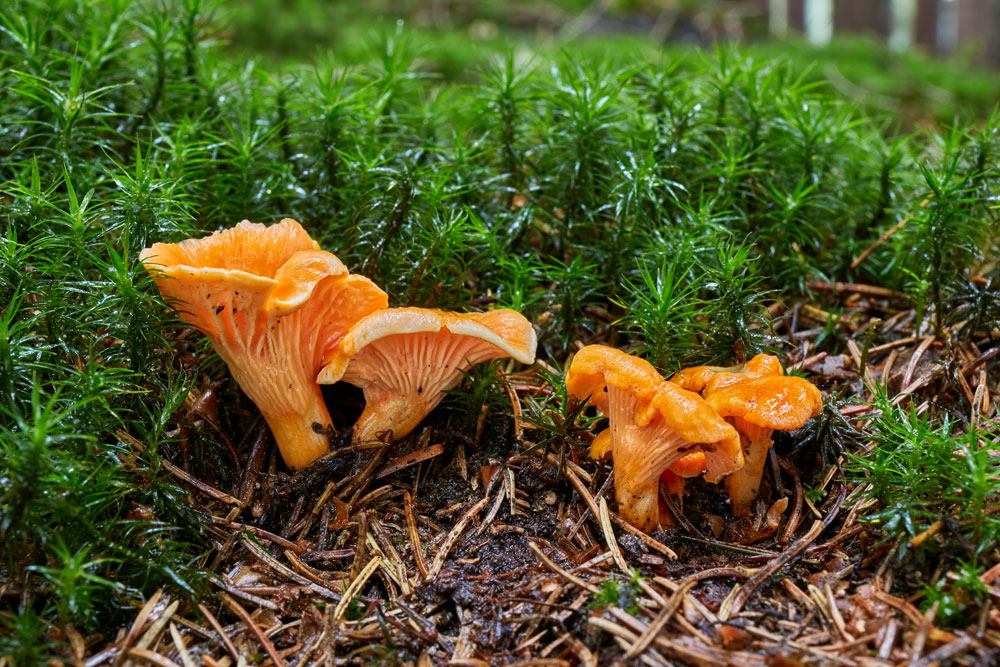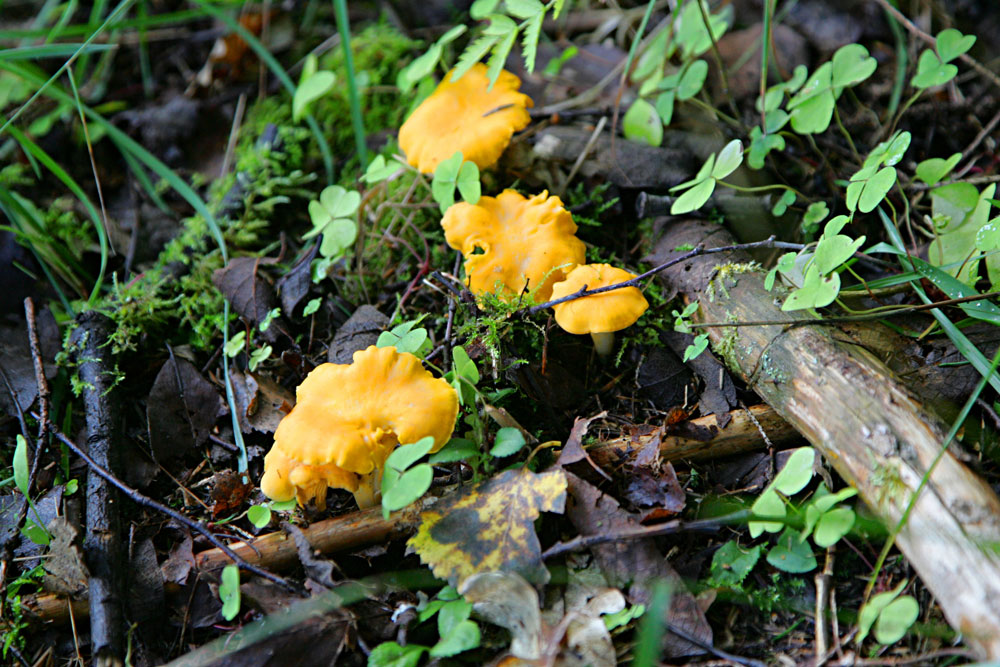Unlike most other species of commonly consumed mushrooms, chanterelle mushrooms cannot be grown commercially; you have to forage them, which is why they're so expensive. These mushrooms grow extensively throughout the continental U.S. and are easy fungi to find, clean, and cook.
A harbinger of early fall, chanterelles add a peppery smokiness to your dishes, and you gain an added thrill by finding these mushrooms in the forest. Here are some more specifics about how and where to find these tasty morsels, and what to do with them after finding them.
What Are They?
Chanterelles refer to a family of mushrooms that all go under the same name of chanterelle, even though technically they all aren't chanterelles. Cantharellus cibarius specifically refers to golden chanterelles. The other species—Gomphus, Polyozellus, and Craterellus—all resemble chanterelle mushrooms closely, so the name is used interchangeably.
In mushroom identification, one of the easiest ways to distinguish chanterelles from other, more poisonous species like the Jack-o-Lantern mushroom, is by examining their gills.
Chanterelle mushrooms have false gills, which appear as wrinkles on the underside of its cap. True mushroom gills are separate from the fungus and can be removed easily.
The chanterelle's false gills are a part of the mushroom's body, they are hard to remove, and it is hard to discern the perimeters of each separate gill. They look like wrinkly folds melted onto the stem and cap. Additionally, the stem on a chanterelle isn't hollow, and there are no rings around the base.
The final way to discern a chanterelle from its nausea-inducing cousins is the aroma. If, when you pick it, the mushroom smells faintly sweet, like apricots, it is most likely a chanterelle.

Golden Chanterelles
Golden chanterelles are also known as orange chanterelles, and they are one of the most well-known and widely sought-after types of wild mushrooms. Chefs commend golden chanterelles for their light peppery flavor. When cooked, they provide dishes with a lovely earthy taste with a hint of almond-like nuttiness.
The color can be a vibrant yellow or gold and deepens into shades of orange. It's easy to pick out a cluster of chanterelles, as they stand out against the green of summer, their growing season. Often you'll find an array of colors in the same fungi patch, from sand to sunflower to peach.
They average two inches in diameter but can grow up to five. The cap is wavy and shaped like a funnel.
Where and When Do They Grow?
Chanterelles love hot, humid, damp weather. They grow throughout the United States except for Hawaii and do exceptionally well in hardwood forests near water sources.
One reason that chanterelles are so difficult to cultivate is that these mushrooms are mycorrhizal, which means the roots of green plants and chanterelles have a symbiotic association. The chanterelle forms a sheath on the root tip of the plant or tree and gains carbohydrates and nutrition from it.
These particular mushrooms love the humid high heat of late summer, but you can find them into early fall in some more Southern states. A drenching rainstorm followed by some days of scorching heat is the perfect combination for late summer foraging for chanterelles.
How Do You Harvest and Clean Chanterelles?
When you're mushroom hunting, bring a basket, a pair of gardening gloves, and a sharp paring knife. Although it's easy enough to twist the chanterelle out of the soil, cutting it out is preferable for two reasons. First, it keeps the dirt out of your basket, and second, keeping the base intact in the soil may support annual regeneration.
Once you get them home, you may be tempted to stick them in the fridge and clean them later. This is a mistake, as the dry air in most refrigeration units evaporates the moisture on mushrooms while the dirt is still on them. The dirt will dry on the fungi and become increasingly difficult to remove.
The easiest way to clean them is to break them in half and use a toothbrush to brush them free of dirt in the field. Store them in your fridge in a paper bag and use them within 10 days. Do not store chanterelles damp, as this will significantly shorten their lifespan.
Cooking, Preserving and Storing Chanterelles
Cooking chanterelles can be as straightforward or as complex as you'd like. These mushrooms pair well with a wide variety of dishes, including wild game like rabbit or venison and sturdy red wines like a cabernet. Thyme, tarragon, chervil, and chives all taste lovely with these fungi.
You can also preserve them by dehydrating and powdering them for use as a flavoring for soups, stocks, and stews. Pickling them is also another option, although some say pickling should be reserved for the smallest and youngest fungi. A long-term way to store your chanterelles is by sauteing in butter, and then freezing the mixture in ziplock bags. You can then add the thawed mushrooms to risotto or pasta.

Final Thoughts
Foraging for chanterelles in late summer or early fall connects your dining room table with the world outdoors. When you go mushroom hunting, it's not just about finding something delicious to eat; there is an added layer of satisfaction when you have foraged and found the food you're eating.
Next time you spy a patch of golden mushrooms in the shade of some hardwoods, take the time to check them out; you won't be sorry you did.






























